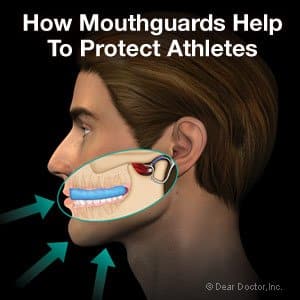Today most adults recognize that leading a healthy, active lifestyle is a big plus. Moderate exercise has been shown to help lower blood pressure, keep cholesterol levels under control, and even reduce feelings of anxiety or depression. To stay active, some 150 million adults in the United States get involved in sports or physical recreation every year. And every year, some of those active folks wind up being treated for sports-related dental injuries.
Who is apt to suffer this kind of injury? Men are more likely than women, but only by a few percentage points. For both sexes, the injury rate falls off rapidly after the teen years — although older athletes tend to have more severe problems. But if you thought that contact sports like football and hockey produced the greatest number of injuries…then it’s time to think again: Adult males are far more likely to be injured playing basketball!
Baseball, bicycling, handball, skiing, surfing and equestrian sports — plus some two dozen others — are activities that the American Dental Association (ADA) has identified as potential causes of dental injury in adults.
Don’t get us wrong: There’s no question that the benefits of physical activity far outweigh the possibility of being hurt. But when serious dental injury occurs, it can result in pain, time taken away from work or the family, and high treatment costs — which often aren’t covered by insurance. If you had a piece of equipment, endorsed by the ADA, which could reduce the risk of sports-related dental injury by 60 times… would you use it?
An Indispensable Part of Your Sports Gear: The Mouthguard
A high-quality, custom-made mouthguard should be part of every athlete’s equipment. What’s a mouthguard? It’s a small protective device that fits over your teeth and absorbs the force of an impact, helping to protect the mouth from damage. There are different kinds of mouthguards, available from various sources. They include:
- “Off-the shelf” types. Found in some sports retailers and big-box stores, these inexpensive guards come in S-M-L sizes, and are generally worn by clenching them between the teeth. They are probably better than nothing, if you don’t mind wearing them—but they can be uncomfortable, and are of uncertain quality.
- “Boil and bite” guards. This type of mouthguard is meant to be softened by heat, and then molded into shape by fingers, teeth and tongue. It’s a better choice than the first kind, but there can be wide variation in how much mouth coverage these guards provide—and in their effectiveness.
- The custom-fabricated mouthguard. This is the one that’s made just for you: First a model of your teeth is prepared, and then is individually fabricated into a piece of protective gear for a perfect fit. It’s strong, lightweight and comfortable — which means you can wear it comfortably. Because, after all, if you don’t wear it, it doesn’t help.

Custom-made mouthguards are an indispensable piece of equipment — especially when they could save you the inconvenience (and potentially much higher cost) of restoring or replacing teeth. So if you’re the active type, consider having a custom mouthguard made for you. It’s the best way to prevent a dental injury from spoiling your game.

